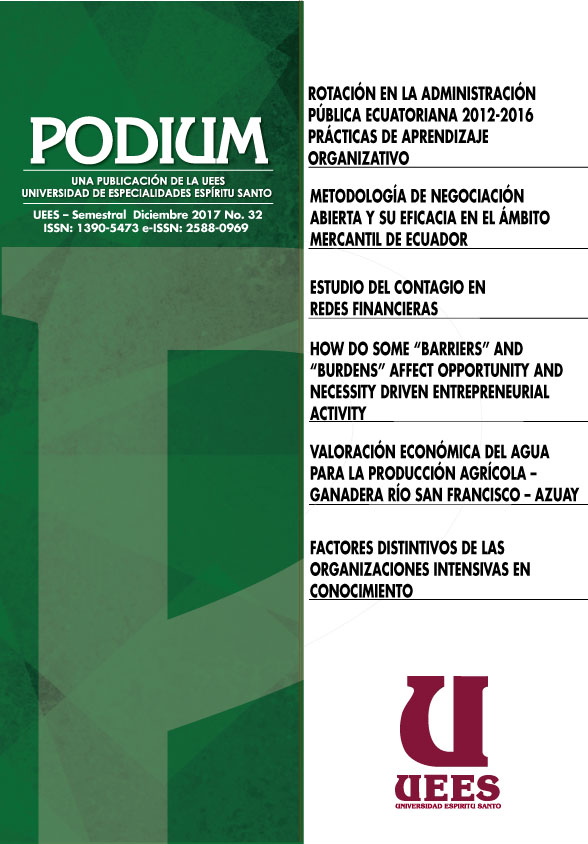Study of Contagion in Financial Networks
Main Article Content
Abstract
The purpose of this article was to study the formation of financial networks and determine idiosyncratic shocks in case of contagion, based on the application of Gai and Kapadia, and Acemoglu, Ozdaglar and Tahbaz-Salehi models. The theory explained the operation of the network and how the connection of interbank assets and liabilities is defined between them. The studies concluded that the amount of loans issued by a bank should not exceed the assets it owns, because if this happens, the system will be exposed to a cascade of defaults. In addition, contagion would depend on the size of sensitive groups within the financial network, the degree of vulnerability of each bank, and how they are connected to each other.
Downloads
Article Details

This work is licensed under a Creative Commons Attribution-NonCommercial 4.0 International License.
When an article is approved, the author or authors keep the rights or authorship and cede to PODIUM the right to be the first able to edit it, reproduce it, exhibit it and communicate it by printed or electronica media.
In order to reinforce our open access policy, PODIUM journal is published under a license named “Creative Commons Attribution-NonCommercial 4.0 International (CC-BY-NC 4.0)”. This license allows sharing (copying and redistributing the material in any means or format) and adapting (re-mixing, transforming, and creating starting from the material). Corresponding credits must be given and no commercial use of the materials is allowed.
Partial or complete reproduction of articles published in PODIUM is authorized, as long as the author is appropriately cited as the source and the reproduction has no commercial purposes.
References
Acemoglu, D., Ozdaglar, A., y Tahbaz-Salehi, A. (2014). Systemic Risk in Endogenous Financial Networks. Kellog School of Management, Northwestern University.
Allen, F. y Gale, D. (2000). Financial contagion. Journal of Political Economy 108, 1–33.
Amini, H., Cont, R., y Minca, A. (2016). Resilience to Contagion in Financial Networks. Mathematical Finance: An International Journal of Mathematics, Statics and Financial Economics, 26(2), 329-365.
Battiston, S., Gatti, D., Gallegatti, M., Greenwald, B., y Stiglitz, J. (2009). Liaisons dangerousness: increasing connectivity, risk sharing, and systemic risk. Journal of Economic Dynamics and Control, 36 (8), 1121-1141.
Caldarelli, G., Chessa, A., Pammolli, F., Gabrielli, A., y Puliga, M. (2013). Reconstructing a credit network, Nature Physics, 9, 125–126.
Chavarría, A. (2014). Redes Bancarias y Riesgo Sistemático: Desarrollo de un Algoritmo de Análisis y Diagnóstico. Centro de Regulación y Estabilidad Macrofinanciera. Facultad Economía y Negocios, Universidad de Chile.
Dasgupta, B. y Kaligounder, L. (2003). On global stability of financial networks. Journal of Complex Networks, 2(3), 313–354.
Demange, G. (2015). Contagion in Financial Networks: A Threat Index. CESifo, Center for Economic Studies & Ifo Institute. Working Paper No. 5307.
Elliot, M., Golub, B., y Jackson, M. (2014). Financial Networks and Contagion. American Economic Review, 104(10), 3115-3153.
Freixas, X., Parigi, B., y Rochet, J. (2000). Systemic risk, interbank relations, and liquidity provision by the central bank. Journal of Money, Credit and Banking, 32, 611–638.
Gai, P. y Kapadia, S. (2009). Contagion in financial networks. Crawford School of Economics and Government. Bank of England.
Gai, P. y Kapadia, S. (2010). Contagion in financial networks. Bank of England. Working Paper No. 383.
Glasserman, P. y Young, P. (2016). Contagion in Financial Networks. Journal of Economic Literature,54(3), 779-831.
Klinger, T. y Teply, P. (2014). Systemic Risk of the Global Banking System an Agent-Based Network Model Approach. Prague Economic Papers, 1.
Leitner, Y. (2005). Financial Networks: Contagion, Commitment, and Private Sector Bailouts. The Journal of Finance,60(6).
May. R, Levin, S., y Sugihara, G. (2008). Ecology for bankers. Nature, 451, 893-895.
Nier, E., Yang, J., Yorulmazer, T., y Alentorn, A. (2008). Network Models and Financial Stability. Bank of England. Working Paper No. 346.





